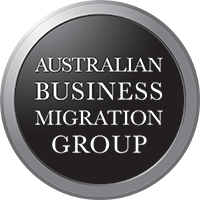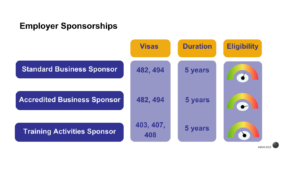Employer Sponsored Visas
Australia offers several employer sponsored visas that allow skilled workers from overseas to live and work in the country.
Which sponsorship is for you?
Here’s an overview of the employer-sponsored visas and the differences between standard business sponsors, accredited business sponsors, and Training Activities sponsors.
Standard Business Sponsor
This process involves applying for approval to be a Standard Business Sponsor (SBS). Employers will have certain obligations set by the Department of Home Affairs, ensuring the welfare and the rights of sponsored employees.
Standard Business sponsors can sponsor employees for:
- 482 visas
- Skilled Employer Sponsored Regional (Provisional) visa (subclass 494)
Standard Business Sponsorship lasts for 5 years. Its recommended to renew a employer’s SBS 2- 3 months before its due to expire.
Accredited Business Sponsorship
Accredited Business Sponsorship (ABS) is an enhanced status that eligible businesses can attain.
Accredited sponsors often experience faster processing times for visa applications, benefiting both the employer and the sponsored employee.
Accredited Business sponsorships involve a more in depth application process, including having been a standard business sponsor for at least a year and having made a significant investment in Australia of at least A$50 million.
Training Activities Sponsors
Training Activities sponsors can nominate overseas workers for the Training visa (subclass 407), allowing them to participate in occupational training and skill development programs.
The Training visa is divided into several streams, including workplace-based training, structured workplace-based training, and professional development.
Employers seeking to become Training Activities sponsors must demonstrate their commitment to providing high-quality training opportunities and comply with the specific requirements outlined by the Australian government.
Becoming an employee sponsor
The main components to becoming an approved employer sponsor include:
- being a legally established and currently operating business
- demonstrating a commitment to employing Australian workers
- understanding your employer responsibilities as a business sponsor.
We advise employers on how to achieve this status and represent businesses when applying to be a sponsor.
How to show your business is legally established
You will need to present certificates of its Australian Company Number and/or Australian Business Number, or its Australian Registered Body Number (for overseas businesses registered to operate in Australia) or your entity’s country of origin business registration number if you are not yet operating in Australia.
Contact us if your business is a trust, joint venture or a franchise.
How to show your business is currently operating
For established businesses, the Department of Home Affairs will want to see evidence showing the business is currently operating.
That’s why they want to see profit and loss statements and the company’s latest annual report.
Smaller businesses or growing enterprises will need to present tax returns, business activity statements and bank statements.
For start ups and new businesses, evidence like lease agreements or a contract of sale are among the documents you’ll need to present.
There are also provisions for businesses who are not yet operating in Australia to enable them to become a standard business sponsor.
How to show your commitment to employing Australian workers
You will need to confirm in writing that you have a strong record of employing Australian workers, or proven commitment to employing local labour.
You must also declare that you will not engage in discriminatory recruitment practices.
We help employers with these attestation letters.
What are the employer’s responsibilities as a business sponsor?
When you are granted the status of being a business sponsor, you are also agreeing to meet your obligations as a sponsor. These obligations begin the day you receive your sponsorship status is approved or the nominated employee starts work with you. It ends when you no longer employ the visa holder and your sponsorship status expires.
When you sponsor an employee for a 482 visa, you must engage through a written contract.
The employment conditions of the sponsored employee must be, at the very least, the same as those for an Australian worker in the equivalent position.
You will need to keep records while you are a business sponsor. These include:
-
-
- the written contract between you and the sponsored employee
- earnings paid to the employee (keeping records of the payslips or pay summaries is ideal)
- any non-monetary benefits offered to the sponsored employee (this could be the use of a vehicle or help with health insurance etc)
- details of the tasks performed by the sponsored employee and where (this record is also very useful if you choose to sponsor your employee for a permanent residency visa down the track)
- details of requests for and payment of travel costs for the employee or their family.
-
Standard business sponsor cost
The government cost of applying to become a standard business sponsor is AUD 420.
How long does it take to become a standard business sponsor?
Once all the standard business sponsor documents have been prepared and lodged, it usually takes around week for approval to be granted.
How do you sponsor an employee?
Once your business has been granted its standard business sponsor status, as the employer you must make the case for sponsoring a skilled worker.
Occupation
If you want to sponsor a worker for a 482 visa, you will need to nominate the applicant for an occupation. The occupation must be on the skilled occupation list that covers 482 visas.
Labour Market Testing
You will need to prove you cannot find an Australia worker to fill your vacancy. To do this, you will need to carry out Labour Market Testing. This involves advertising the position to Australians and the local market for a minimum of 28 days prior to nominating the position for a visa.
There are different ways you can advertise the position, such as through a recruitment agency or via job platforms. What’s important is presenting evidence showing when the search began.
Genuine Position
The Department asks to see evidence to prove the position is genuine to ensure the integrity of the visa sponsorship system. The evidence includes presenting job descriptions, the function it plays in your company.
482 nominations must be for full time positions of 38 hours a week or hours that are part of an industry award, agreement or in line with National Employment Standards.
Salary
You’ll need to show that the position pays the annual market salary rate (AMSR) for that occupation in the location where the job will be based.
Positions offering salaries that do not meet the annual market salary rate and/or offer salaries under $70,000 per annum are not eligible for sponsorship. (The $70,000 is the current Temporary Skilled Migration Income Threshold (TSMIT).
Top Tip: superannuation is not part of an employee’s base salary. Your employment contract needs to show the salary and superannuation are separate. Applications have been refused before because the separation of salary and superannuation is not clear.
Exemptions: This does not apply for salaries above $250,000 or for applicants from certain countries with trade agreements with Australia.
Written Contract
Whether you are an Australian business or an overseas business, you must present the employment contract. This is a place to show the employment conditions
We advise employers on their contracts from the perspective of meeting the 482 sponsorship requirements.
Employment Conditions
When you nominate the position for sponsorship, the employment conditions of the nominated employee must be at the very least the same as Australians working in an equivalent role in the same the location.
Proving this typically involves presenting examples of salaries of existing employees in equivalent roles at your business. However, it can also involve sourcing salary examples other operators in the area.
No Adverse Information
You will need to confirm there is no adverse information about you, your business, or anyone associated with your or your business. The Department of Home Affairs will assess information that raises concerns about you being a suitable sponsor or relates to something that has happened in the previous 3 years.
For example, if you or your organisation has become insolvent under the Bankruptcy Act, the Department of Home Affairs will regard that as adverse information and question your / your business’s suitability to sponsor an employee.
Other examples are if you or your organisation:
has been found guilty by a court of an offence
has been found to have contravened the law by a competent authority
has been the subject of administrative action, including being issued a warning, by a competent authority
is being investigated
has been subject to disciplinary or legal action
These matters relate to laws affecting:
discrimination
immigration
industrial relations
occupational health and safety
people smuggling or related offences
slavery, sexual servitude and deceptive recruiting
taxation
terrorism
people trafficking or debt bondage
The Department of Home Affairs also advises “Some adverse information is unlikely to affect our decision. For example, it is not relevant if we learn your business was fined for operating an unregistered vehicle on a public road. But it would be relevant if we learn your company director is being investigated for people trafficking offences”.
If you are concerned about something that you believe might be considered adverse information, we can discuss this confidentially. We can find out if its likely to affect the visa nomination decision or indeed your sponsorship status.
We have bought a business that employs 482 visa holders. What do we do?
When the sponsor of 482 visa holders or 494 visa holders changes, such as when a business changes hands, the new employer will need to sponsor the 482 visa holders, assuming the new employer wants to keep employing them. This means the new employer will need to apply to obtain the status of being a Standard Business Sponsor.
Do all temporary work visas need a standard business sponsor?
No, not all temporary work visas require the employer to be a standard business sponsor. The 407 Training visa, the 408 Temporary Activity visa and the 485 Graduate visa are temporary work visas that do not require the employer to be a standard business sponsor.
Sources: Department of Home Affairs, Australian Government; Federal Register of Legislation
I want to sposnor an employeeSponsoring an employee: how we help businesses and applicants
We help Australian employers sponsor skilled workers where skills shortages are being felt. For over ten years, we’ve provided professional migration advice through our registered migration agent to businesses located throughout Australia. We service a range of sectors, including IT, mining, agriculture, horticulture, veterinary science, transport and logistics, dentistry, health and beauty and hospitality.
We represent clients across Australia with visa advice in Perth, Melbourne, Sydney, Adelaide. We also provide migration advice to regional areas.
We represent both employers and employees with their Australian work visas matters, whether they’re applying for their first temporary skilled visa or transitioning to a permanent skilled visa.

Sponsoring an employee: John’s story
Employer, John Burns came to the Australian Business Migration Group’s Perth migration agent when his business needed to sponsor skilled employees for temporary skilled work visas. John returned to our Perth migration agent, Greg Nicolson, when his employees could transition to permanent residency through a sponsored permanent skilled visa via the Employer Nomination Scheme.


